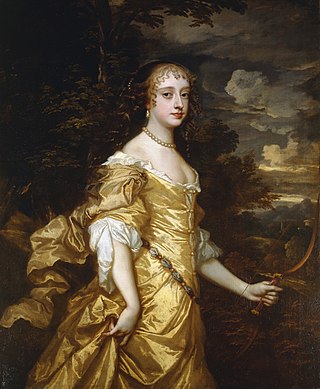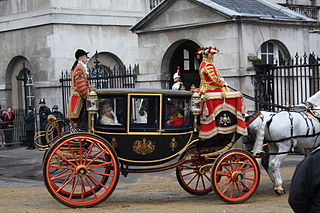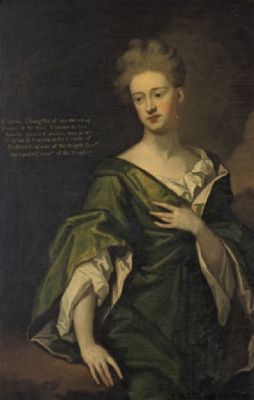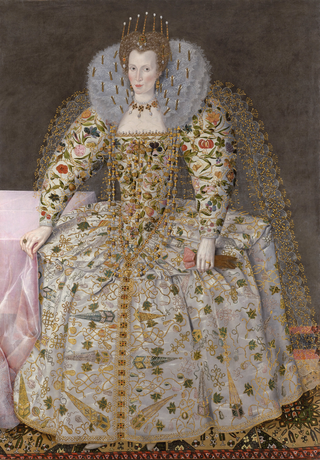
A lady-in-waiting or court lady is a female personal assistant at a court, attending on a royal woman or a high-ranking noblewoman. Historically, in Europe, a lady-in-waiting was often a noblewoman but of lower rank than the woman to whom she attended. Although she may either have received a retainer or may not have received compensation for the service she rendered, a lady-in-waiting was considered more of a secretary, courtier, or companion to her mistress than a servant.

The mistress of the robes was the senior lady in the Royal Household of the United Kingdom, who would, by appointment, attend on the Queen. Queens dowager retained their own mistresses of the robes. In the 18th century Princesses of Wales had one, too.

Frances Teresa Stewart, Duchess of Richmond and Lennox was a prominent member of the Court of the Restoration and famous for refusing to become a mistress of Charles II of England. For her great beauty she was known as La Belle Stuart and served as the model for an idealised, female Britannia. She is one of the Windsor Beauties painted by Sir Peter Lely.
Sir George Carew was an English diplomat, historian and Member of Parliament.

Lady of the Bedchamber is the title of a lady-in-waiting holding the official position of personal attendant on a British queen regnant or queen consort. The position is traditionally held by the wife of a peer. A lady of the bedchamber would give instructions to the women of the bedchamber on what their queen wished them to do, or may carry out those duties herself.

In the Royal Household of the United Kingdom the term Woman of the Bedchamber is used to describe a woman attending either a queen regnant or queen consort, in the role of lady-in-waiting. Historically the term 'Gentlewoman of Her Majesty's Bedchamber' was sometimes used. In addition to the Women of the Bedchamber, queens have Ladies of the Bedchamber, and a Mistress of the Robes who is the senior female member of her household. The Women of the Bedchamber are usually in regular attendance, but the Mistress of the Robes and the Ladies of the Bedchamber are normally only required for major events and occasions.

Catherine Howard, Countess of Nottingham, was a cousin, lady-in-waiting, and close confidante of Elizabeth I of England. She was in attendance on the queen for 44 years.
Suo jure is a Latin phrase, used in English to mean 'in his own right' or 'in her own right'. In most nobility-related contexts, it means 'in her own right', since in those situations the phrase is normally used of women; in practice, especially in England, a man rarely derives any style or title from his wife although this is seen in other countries when a woman is the last heir of her line. It can be used for a male when such male was initially a 'co-lord' with his father or other family member and upon the death of such family member became the sole ruler or holder of the title "in his own right" (alone).

Susan Feilding, Countess of Denbigh, was an English courtier. She was First Lady of the Bedchamber to Queen Henrietta Maria from 1626 until her death in 1652.
Elizabeth Boyle, Countess of Guildford, was an English peeress. She was created 1st Countess of Guildford for life at the Restoration on 14 July 1660, which became extinct upon her death c. 3 September 1667. She held the office of Groom of the Stole and Lady of the Bedchamber to the queen dowager, Henrietta Maria.
Anne Hamilton, Countess of Huntly, was a Scottish noblewoman and a member of the powerful Hamilton family which had a strong claim to the Scottish crown. Her father James Hamilton, Duke of Châtellerault, 2nd Earl of Arran was heir presumptive to the throne of Scotland after Mary, Queen of Scots prior to the birth of the latter's son Prince James in 1566. Anne was the wife of George Gordon, 5th Earl of Huntly, Lord Chancellor of Scotland and a chief conspirator during the reign of Queen Mary.
Henrietta Gordon was a Scottish-born courtier, a maid of honour to Princess Henrietta, youngest daughter of Charles I of England.
Nancy Jane Marie Heathcote-Drummond-Willoughby, 28th Baroness Willoughby de Eresby, is an English peer and member of the Astor family. She is a 1⁄4 holder of the office of Lord Great Chamberlain, which is exercised by the 7th Baron Carrington.

In British Royal Households, First Lady of the Bedchamber is the title of the highest of the ladies of the bedchamber, those holding the official position of personal attendants on a queen or princess. The title had its equivalent in several European royal courts. The position is traditionally held by a female member of a noble family.

Cecilia Crofts, courtier and maid of honour to Henrietta Maria, subject of poems.
George Kirke was a Scottish-born courtier and Member of Parliament for Clitheroe.

Anne Killigrew was a Lady in Waiting to Queen Henrietta Maria, and the first wife of George Kirke who was Groom of the Chamber to Charles I of England.
Thomazine or Thomasina or Thomasine Carew was an English courtier.
Lady Mary Russell was a Scottish socialite who was a maid of honour at the coronation of Elizabeth II. She was the youngest maid of honour at the Queen's coronation.
Mother of the Maids was a position at the English royal court. The Mother of the Maids was responsible for the well-being and decorum of maids of honour, young gentlewomen in the household of a queen regnant or queen consort.










